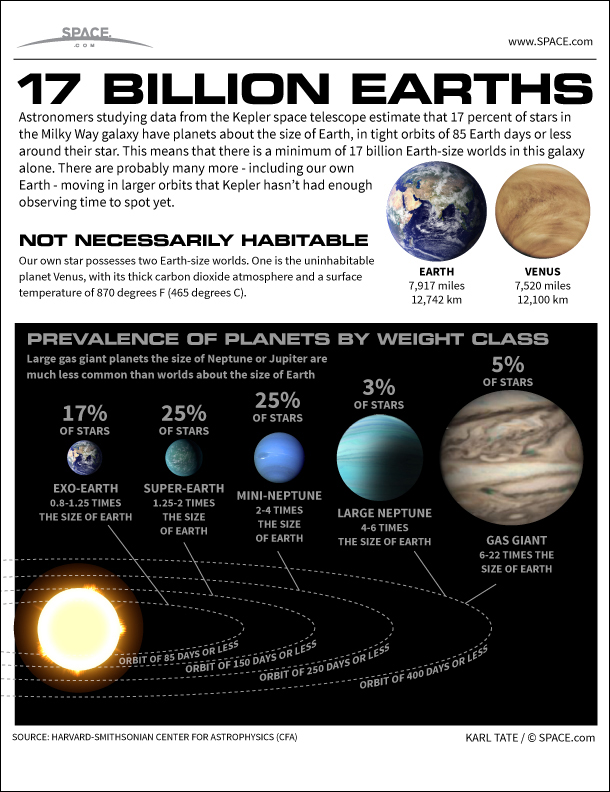17 Billion Earths of the Milky Way Explained (Infographic)

Astronomers studying data from the Kepler space telescope estimate that 17 percent of stars in the Milky Way galaxy have planets about the size of Earth. This means that about one in six stars has an Earth-size companionexoplanet. As there are about 100 billion stars in the galaxy, there are at least 17 billion Earth-size worlds in this galaxy alone.
Our own star possesses two Earth-size worlds. Earth itself, and the uninhabitable planet Venus, with its thick carbon dioxide atmosphere and a surface temperature of 870 degrees F (465 degrees C).
Large gas giant planets the size of Neptune or Jupiter are much less common than worlds the size of Earth.
The study finds that 17 percent of all stars probably have an exo-Earth (a planet 0.8 to 1.25 times the size of Earth) in an orbit of 85 or less Earth days.
About one in four stars have a super-Earth (1.25 to 2 times the size of Earth) in an orbit of 150 days or less. The same number of stars have a mini-Neptune (2 to 4 times the size of Earth in an orbit of 250 days or less.
Larger planets are much rarer. Three percent of stars have a large Neptune (4 to 6 times the size of Earth) and 5 percent have a gas giant (6-22 times the size of Earth) in an orbit of 400 days or less.
The research was done by the Harvard-Smithsonian Center for Astrophysics.
Join our Space Forums to keep talking space on the latest missions, night sky and more! And if you have a news tip, correction or comment, let us know at: community@space.com.
Get the Space.com Newsletter
Breaking space news, the latest updates on rocket launches, skywatching events and more!

Karl's association with Space.com goes back to 2000, when he was hired to produce interactive Flash graphics. From 2010 to 2016, Karl worked as an infographics specialist across all editorial properties of Purch (formerly known as TechMediaNetwork). Before joining Space.com, Karl spent 11 years at the New York headquarters of The Associated Press, creating news graphics for use around the world in newspapers and on the web. He has a degree in graphic design from Louisiana State University and now works as a freelance graphic designer in New York City.
